Mauritania is a country most people can’t find on a map. The few who are familiar with the name often confuse it with the very different Mauritius. It’s a large country and not particularly far to fly to from Europe and the United States, yet it’s one of the least visited. I’m mystified why, as there’s so much to see in its expansive deserts and long Atlantic coastline.
Here the Sahara Desert transitions into the semi-arid Sahel. The people of the northern part of the country resemble the Berber / Arab mix of people found in Morocco and Algeria and the southern part the tribal groups of Mali and Senegal. In the capital Nouakchott, all national ethnic groups live here, navigating the traditional and modern worlds.
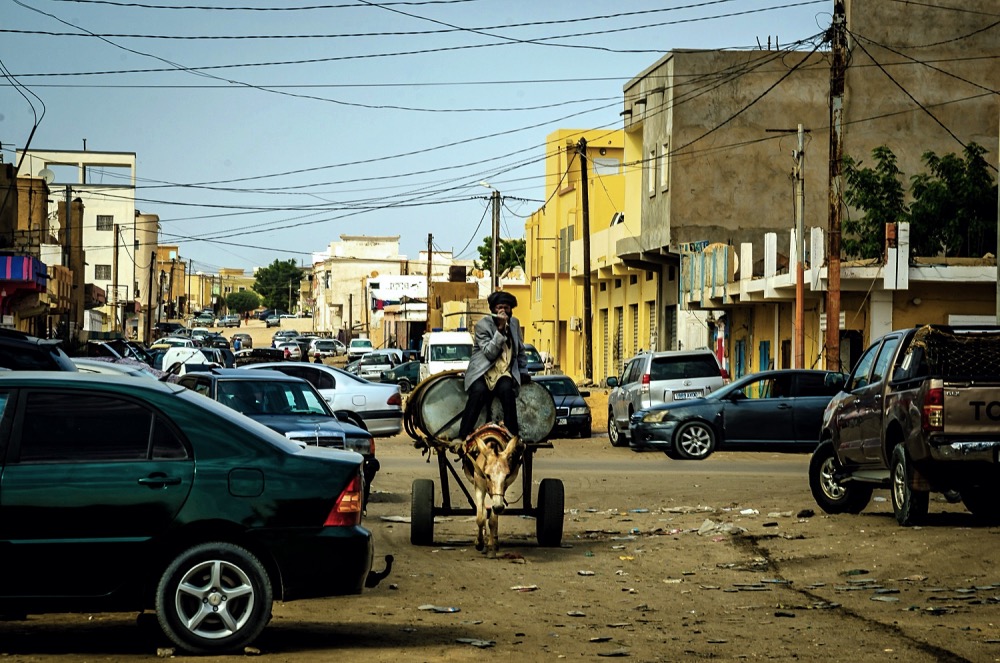
There’s plenty of room in Mauritania, one of the least populated countries, even in the sprawling capital Nouakchott has few buildings over four-stories.
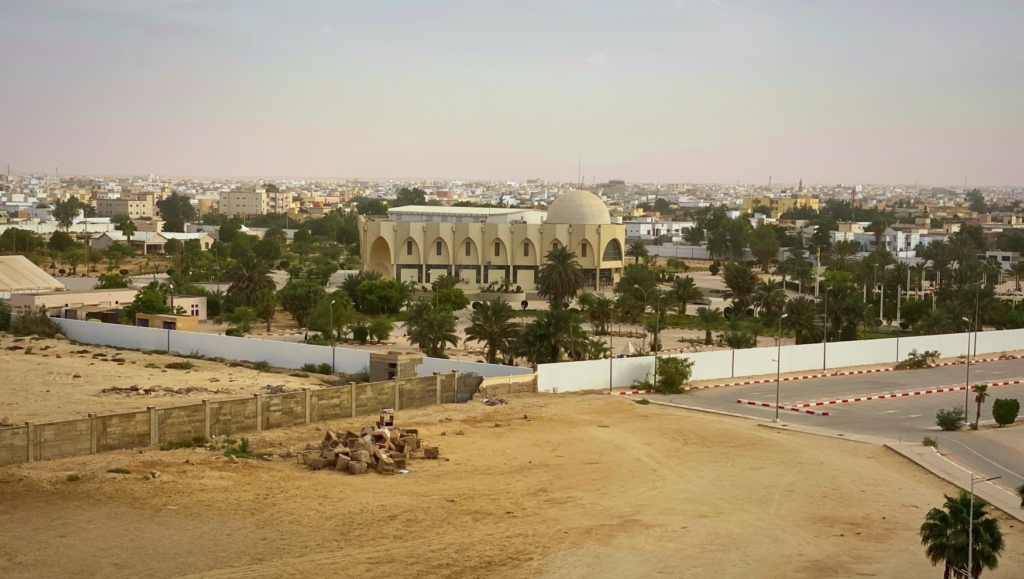
Almost all villages, towns and cities are small. and provide a snapshot into the slower rhythm of life there.
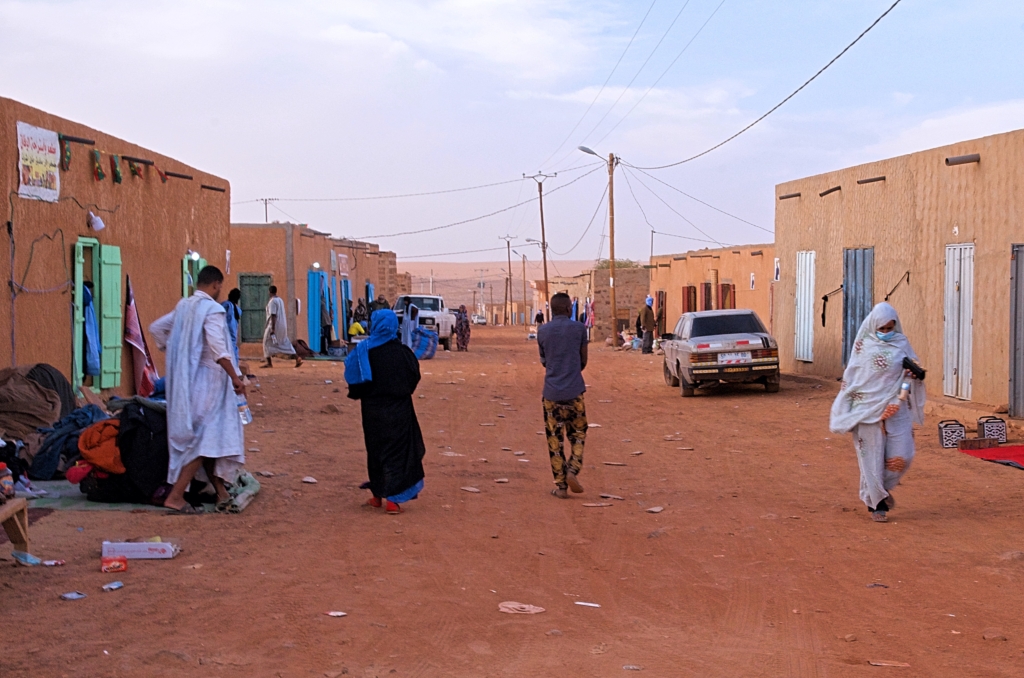
Most of the country is the intermingling of barren deserts and stark landscapes.
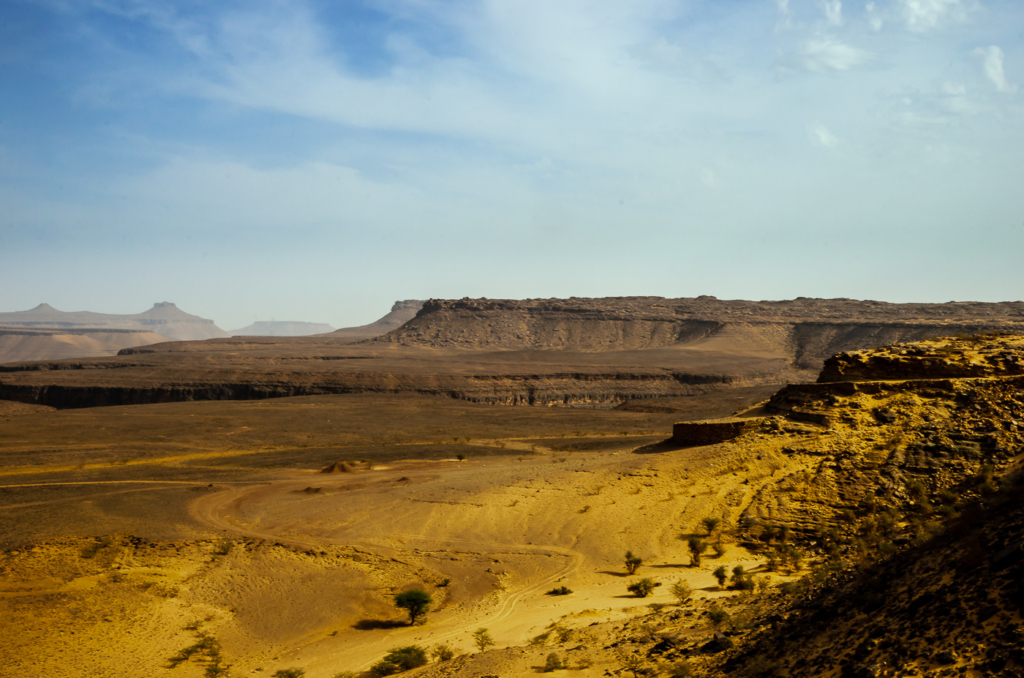
You can drive for hours and the only living and moving thing you see are a few grazing camels or perhaps a line of them returning home.
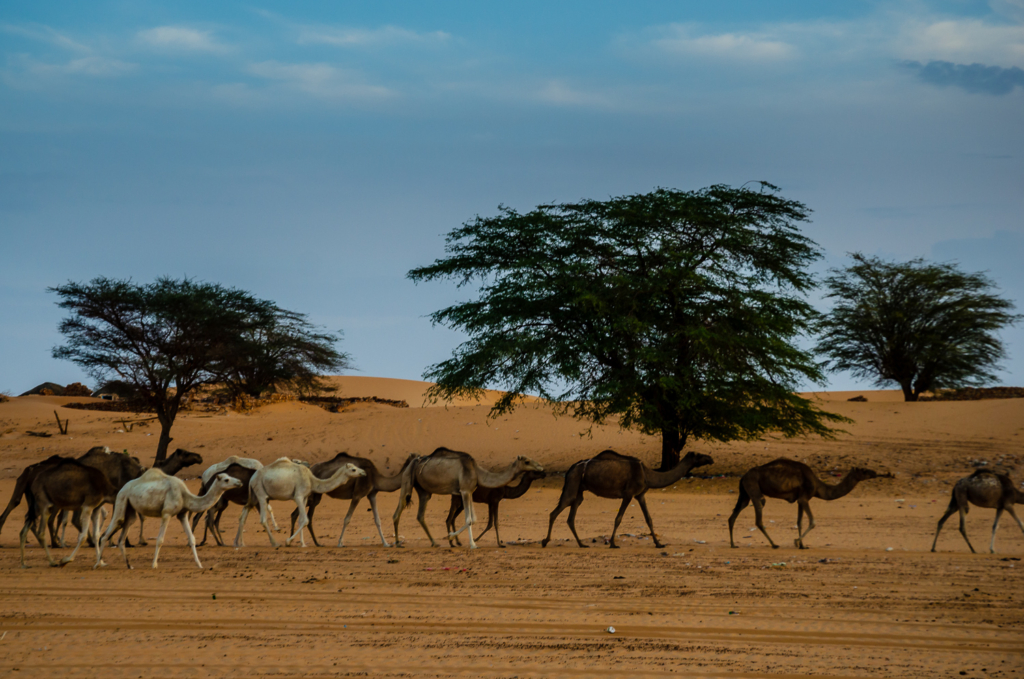
Then seemingly out of nowhere, you meet people who have lived in the desert their whole lives.
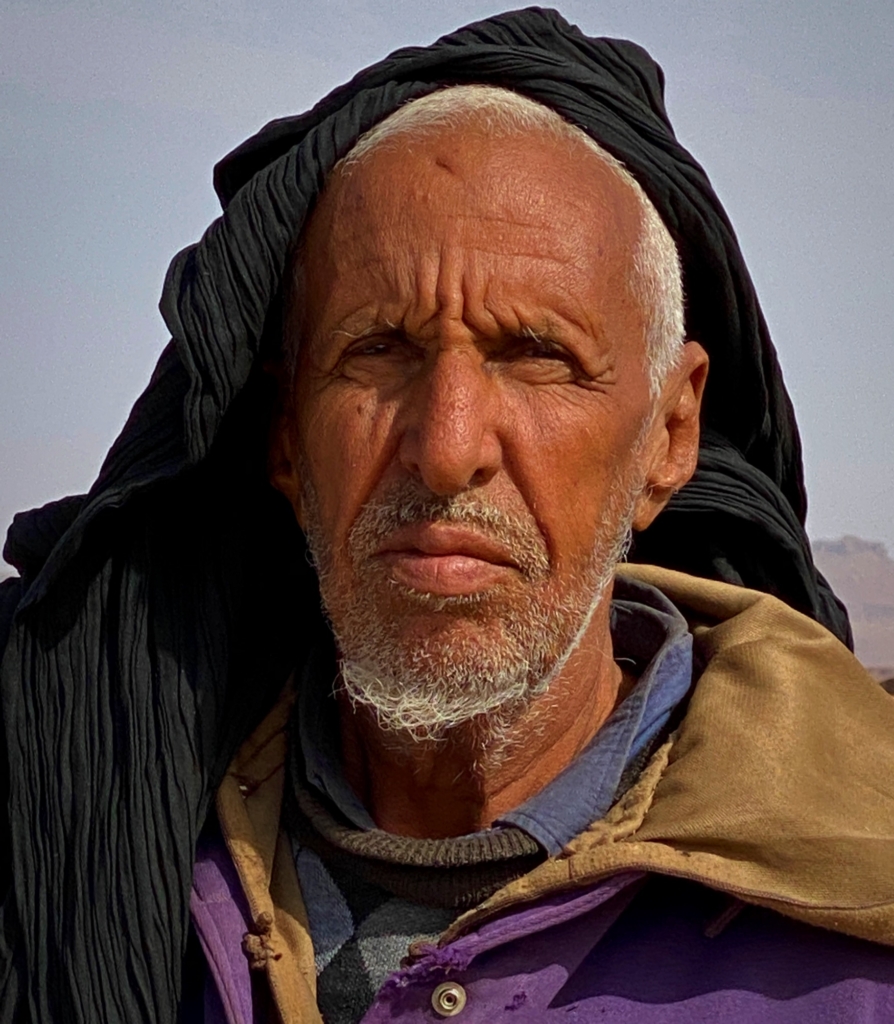
I could go on and on about Mauritania, but if you are intrigued by this intro, you must read on.
Where is Mauritania?
It’s bordered by Senegal, Mali, Algeria and the disputed territory of Western Sahara partially controlled by Morocco.

Why We Went to Mauritania
My wife, Khadija, and I were visiting a friend in Senegal and almost as an afterthought, we decided to spend time in bordering Mauritania. This rather impulsive action turned out to be one of my best travel decisions.
How Long to Spend in Mauritania
We spent one week in Mauritania which is the minimum anyone should consider, given it’s the size of Finland or the combined Texas and Arizona. In two weeks, with an aggressive schedule, you could see all regions of the country. To see the whole country at a reasonable pace and explore a few places off the beaten path would require a month.
Is Mauritania Safe?
It’s a safe country but here, as everywhere you travel, employ basic safety precautions and use common sense to avoid problems.
The police have had accusations of human rights abuses, but not directed towards tourists. The country has fended off insurgent groups which have destabilized Libya, Mali, Niger and Burkina Faso with its military forces.
There are credible reports that some form of slavery exists in the country, although the extent is widely debated and the government vociferously denies it. However, a visitor is unlikely to notice anything in this regard.
Is Mauritania Expensive?
Mauritania, for Americans and others, is generally inexpensive. However, reliable vehicles for driving long distances with drivers could easily be over $300 / day if there’s a guide speaking fluent English or French, and this doesn’t include lodging and food.
Where to Stay in Mauritania
In Nouakchott, there are good hotels for the few tourists that visit each year. We stayed in the Sunset Hotel which was clean, centrally located and offered a hearty buffet breakfast. Outside of Nouakchott, there are inns and guest houses or you can arrange to sleep in a tent in the desert.
How to get around in Mauritania
We used Idoumou, owner of Désert Mauritanie (aka Le Phare du Desert / Lighthouse of the Desert), who has been arranging tours for over 25 years. He is thoroughly professional and can arrange tours in English, French, German, Italian and Spanish. He uses only competent guides and drivers. Because of his connections in the country, he arranged for his son to walk our passports through Immigration, though it still took about 15 minutes. He is as flexible as possible if you want to modify your itinerary.
We had a great driver, Abdellahi, who knew how to drive on sandy surfaces, and also was our cook. Bouha was our excellent guide and he was always thinking of additional places we might be able to fit in.
It’s possible to drive on your own in Mauritania but you would have to negotiate five to ten police and military stops every day and look for gas stations that are few and far apart. You also would have to deal with flat tires, being stuck in the sand and mechanical failure, as you can wait quite a while before you see someone else.
In Nouakchott, you can flag taxis, but it appeared to me they were mostly shared ones and I was told they only travel in one direction. The main way of traveling between cities is in bush taxis, while crowded, could be a lot of fun if you have time and realize virtually everything is communicated in Arabic.
Here’s a map of some of the main attractions in the country.
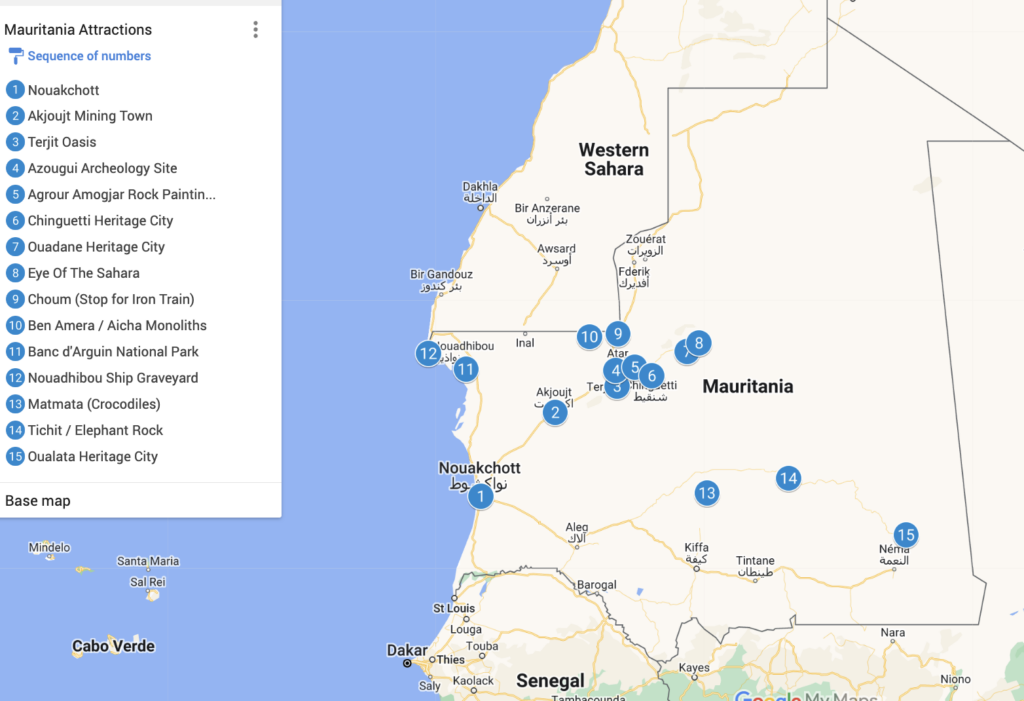
Photography in Mauritania
Photography in Islamic Mauritania can be challenging, as the local population is generally wary of having their pictures taken. In Azougui, I saw this soil and grass-roofed home in the warm sunlight of the early evening and decided to snap a shot.
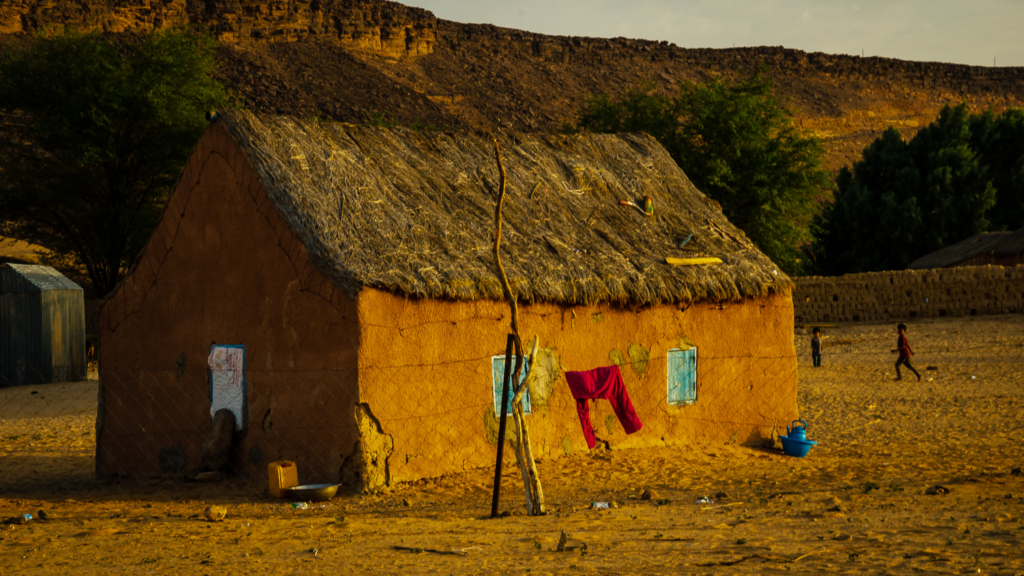
I didn’t notice there were children playing outside, who ran into the house when they saw my Nikon camera. Then the mother came out and carried her young daughter inside. This was definitely something I didn’t intend to happen.
Despite this experience, I found Mauritania to be a wonderful place to photograph, as long as it’s okay with the people in the images. As you see from this post and the photo gallery, it has dramatic landscapes, remarkable architecture and striking people. With my photos, I’ll never forget this unique and special country!
What Languages Are Spoken in Mauritania
Hassaniya Arabic is the main language spoken and it’s noticeably different from Arabic spoken in North Africa and the Gulf. About 15% of the population speaks French regularly. There’s some English, but usually very basic and concentrated with those dealing with tourists.
Brief History Mauritania
Berber people have inhabited this area for thousands of years, engaging in farming and trading. In the early 1st century AD, the Roman Emperor Claudius established eastern and western provinces in the region called Mauretania (essentially meaning “west”) in Morocco and Algeria. However, the name came to be associated with the area south of Roman control, current-day Mauritania.
A few centuries following the decline of the Roman Empire, Arabs invaded and established Islam as the dominant religion. The heritage cities of Chinguetti, Ouadane, Tichitt, and Oualata (all have various spellings in English) were on trade routes which brought wealth and culture to them. They prospered between the 1000 and 1700 AD, then decisively declined.
By the early 1900s, the French controlled much of West Africa including Mauritania, which gained independence in 1960. Since then it has had many coups and changes in leadership.
Mohamed Ould Ghazouani, a high-level military officer who assisted in the coup in 2008, won the 2019 presidential election. His victory marked a democratic transition of power in the country but the military still plays a key role and there are notable restrictions on political freedoms. Occasionally you can see his picture, such as in this rotary intersection in Nouakchott.
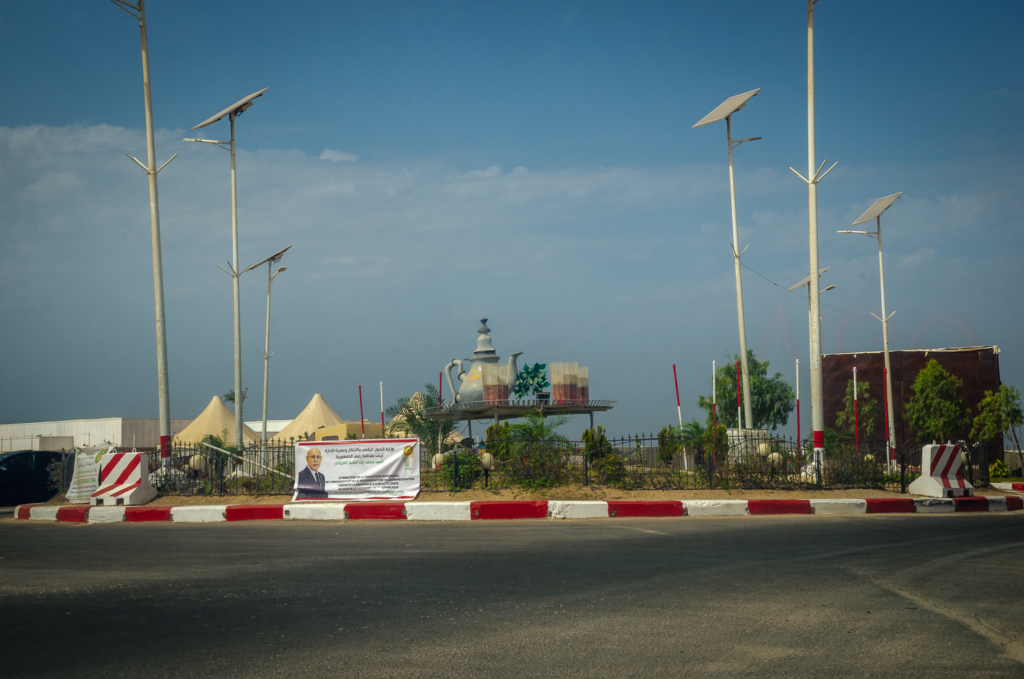
Culture of Mauritania
The vast majority of the population in Mauritania are Sunni Muslims and religion permeates many aspects of daily life. Sufi brotherhoods, who teach ways to achieve spirituality, play a significant role in religious and cultural life. (Sufis can be either Sunni or Shiite.) Some aspects of traditional African religious and cultural practices persist in certain communities.
Mauritania is a conservative society, with traditional gender roles and modest clothing. Arranged marriages are not uncommon, and family ties play a crucial role in social interactions and decision-making.
The boubou is a flowing and loose-fitting robe worn by both men and women. It is often made from lightweight, breathable fabric and provides protection from the elements.
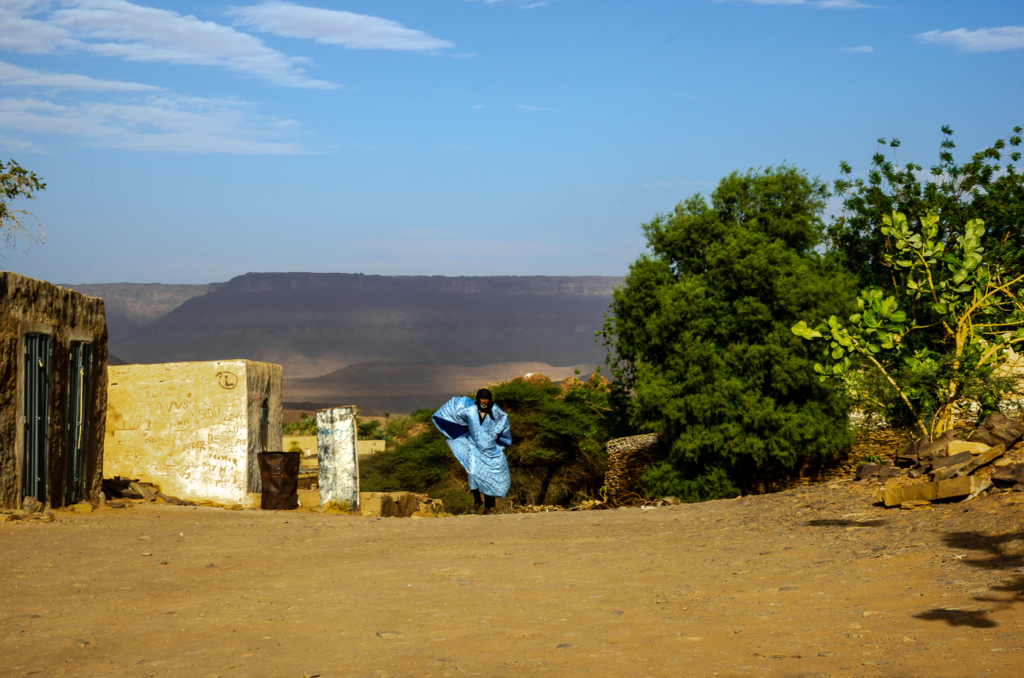
The boubou can vary in style and color, with women’s boubous sometimes being more colorful and intricately decorated.
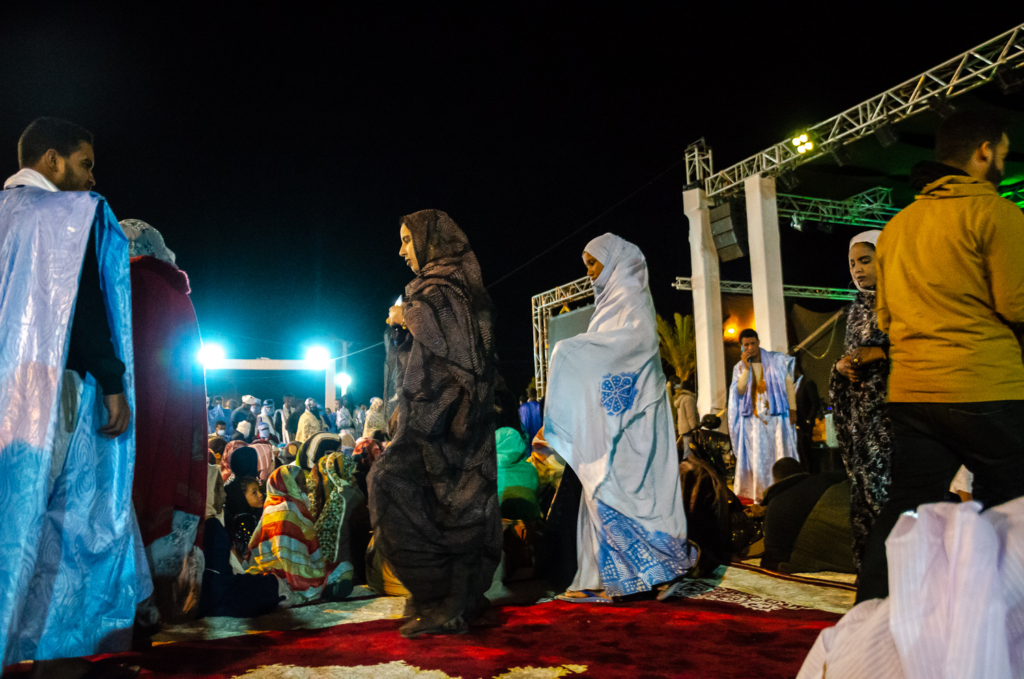
Both men and women in Mauritania may wear turbans or headscarves to shield their heads and faces from the sun and sand. The way the turbans are wrapped can vary based on cultural and regional preferences.
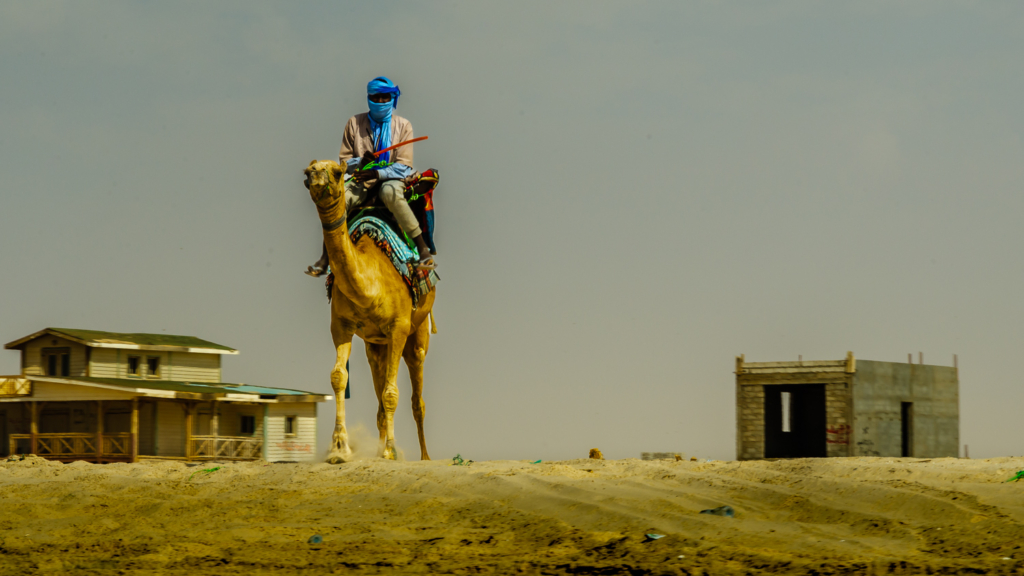
In the past, in some limited cases, young girls were encouraged or pressured to gain weight as a way to conform to traditional standards of beauty, where a larger body size was considered desirable. To accomplish this, sometimes forced eating and overconsumption was employed. This practice has been virtually eliminated after a sustained effort to educate the public of the significant health risks.
Nouakchott, Mauritania
Nouakchott (from Berber, “place of the winds”) is the capital and largest city of Mauritania. The region was historically inhabited by various nomadic groups. Nouakchott’s modern history began with the establishment of a small fishing village called “Cinquième” by the French colonial administration in the early 20th century. The village initially served as a stopover point for travelers and traders, and its population was relatively small.
Nouakchott’s significance grew after Mauritania gained independence from France in 1960. In 1963, the capital was moved from the city of Saint-Louis (now in Senegal) to Nouakchott due to its more central location within the country and access to the ocean. Afterwards, it grew in population as people from all regions of Mauritania, as well as neighboring countries, migrated there. It’s now a sprawling, low density city with building construction everywhere.
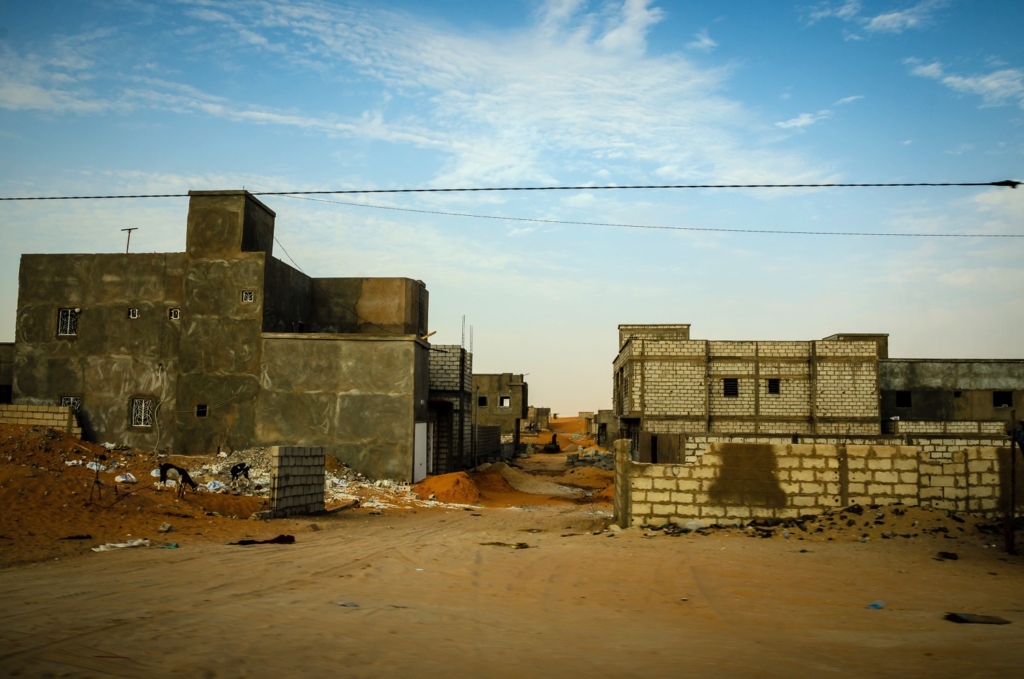
A significant part of the expansion is funded by miners extracting gold and other minerals, working for companies and on their own.
We spent an equivalent of a day and a half, which is the minimum I would recommend.
Marche Capitale
The Marché Capitale is one of the largest and most well-known markets in Nouakchott. It’s a beehive of activity where you can find a wide variety of goods, including fresh produce, clothing, textiles, handicrafts, electronics, household items, and more. Khadija bought fabric from the father and son in the following picture to use as cover to protect her from the sun and wind and to enter religious places.

National Museum of Mauritania
This cultural institution was built in 1972 by the Chinese. The following photo with Khadija and Abdellahi shows the front of the two-story building.
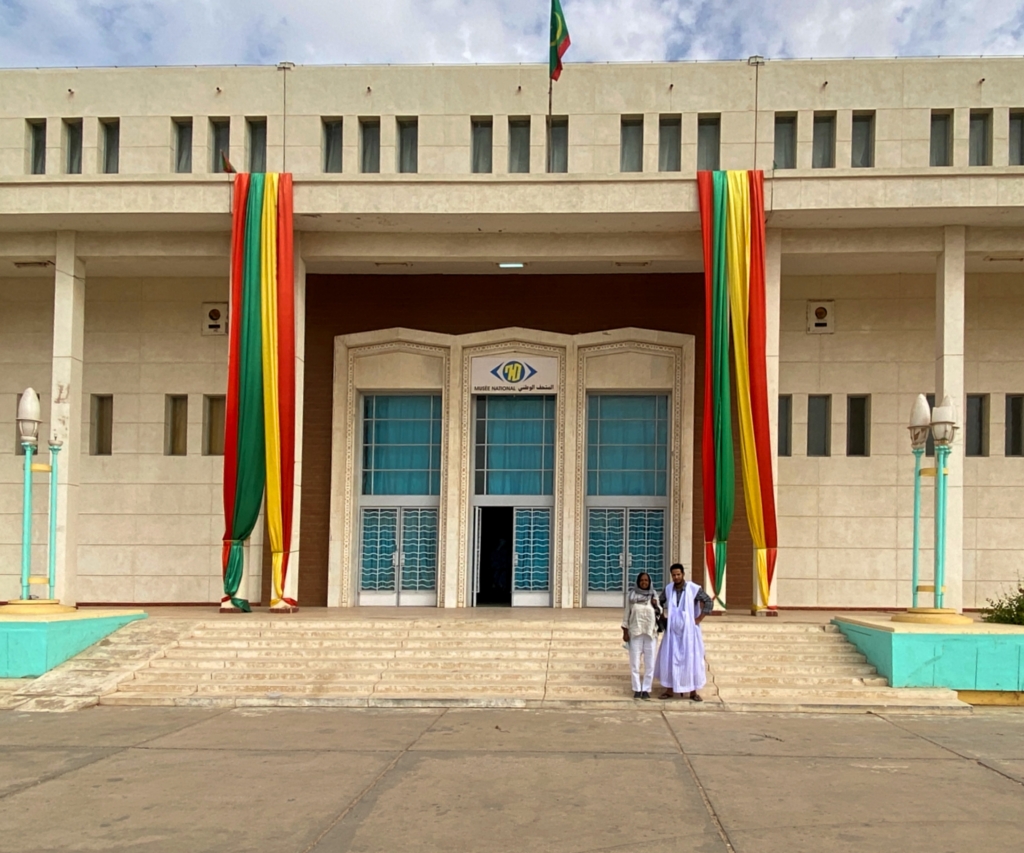
The second floor has permanent galleries open to the public. I’m not sure if it’s usually the case, but we were instructed not to take photos.
We spent over an hour studying the archaeological and ethnographic collections. I was particularly interested in the maps showing the political divisions and controlling powers of the region over the centuries. Exhibits also helped us understand the country’s culture, such as a photo of a bride on a palanquin, on top of a camel, as part of a traditional marriage ceremony.
Camel Market
Mauritania has one of the largest camel markets in Africa. We saw maybe 150 to 200 camels standing, sitting and with some of their legs tied. Men, many in boubous, were feeling their bodies and looking in their mouths.
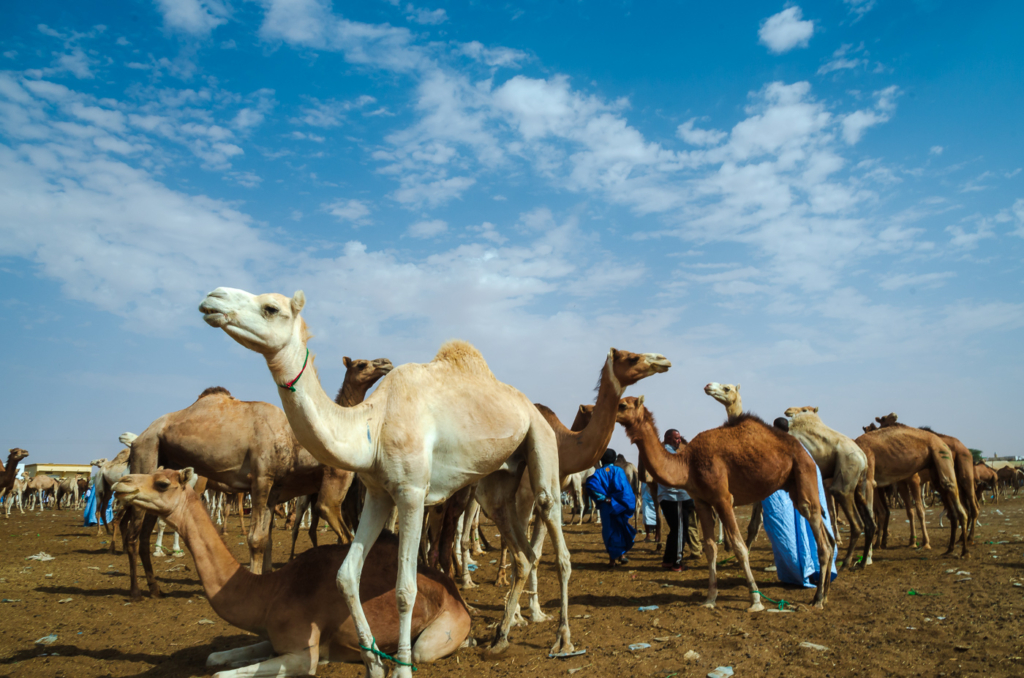
Camels are known for being aggressive, but nothing happened while we were there.
While some tourists come here, it’s a commercial property and you should do nothing to interfere with the camels, buyers and sellers.
Miles of Empty Beach
The beach along the Atlantic coast of Nouakchott is a wide expanse and has white sand extending for miles. I’ve never seen anything quite like it as we didn’t see a soul for literally miles.
It’s a great place for lunch, where the only noises are crashing waves and noisy flocks of birds.
Few swim here as the waves and undercurrents are quite strong. Forget about lifeguards, so if you must swim, do it when currents are subdued and always have a friend watching out for you. You may sometimes see experienced surfers testing the waves.
Port de Pêche (Fishing Port)
This is the most colorful and lively place in Nouakchott and feels like you’ve crossed through a portal and are now in Senegal, possibly St. Louis or Mbour. The fishermen and vendors are mostly Senegalese.

There are several pirogues (long canoes made from one tree) painted with bright strips of color interspersed with pictures of founders of Sufi orders.

While the pirogues are tossing in the waves, men unload the catch and place it in donkey-drawn carts.
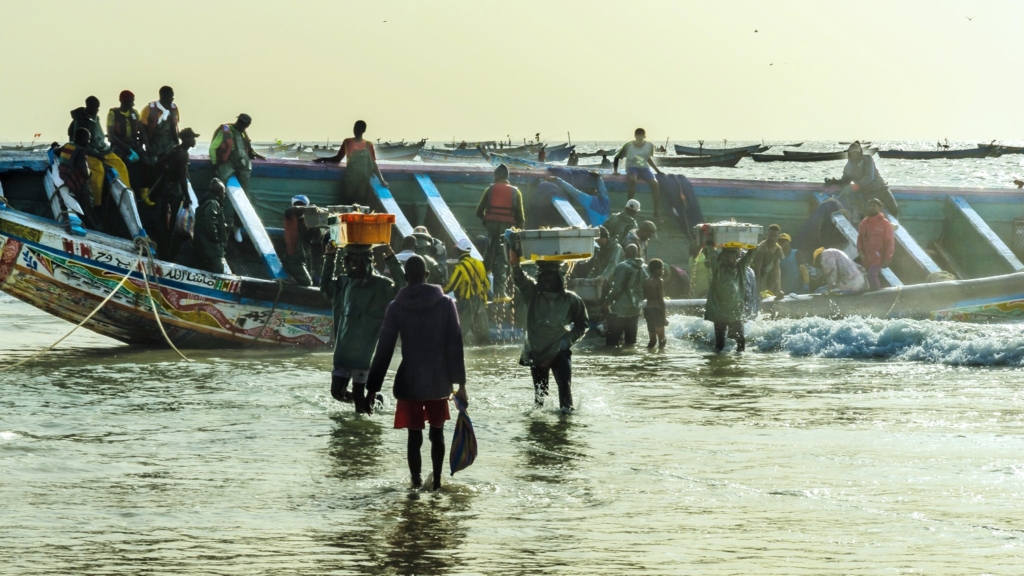
On the beach, men are filling the pirogues with supplies and mending fishing nets, while women are gutting and selling fish. Everyone is both contributing to and unaffected by the general commotion of hustling people moving in every direction.
This should not be missed when visiting Nouakchott.
Terjit Oasis
For the rest of the trip, we traveled in our Toyota Hilux, loaded with blankets, tents, pots, utensils and food.
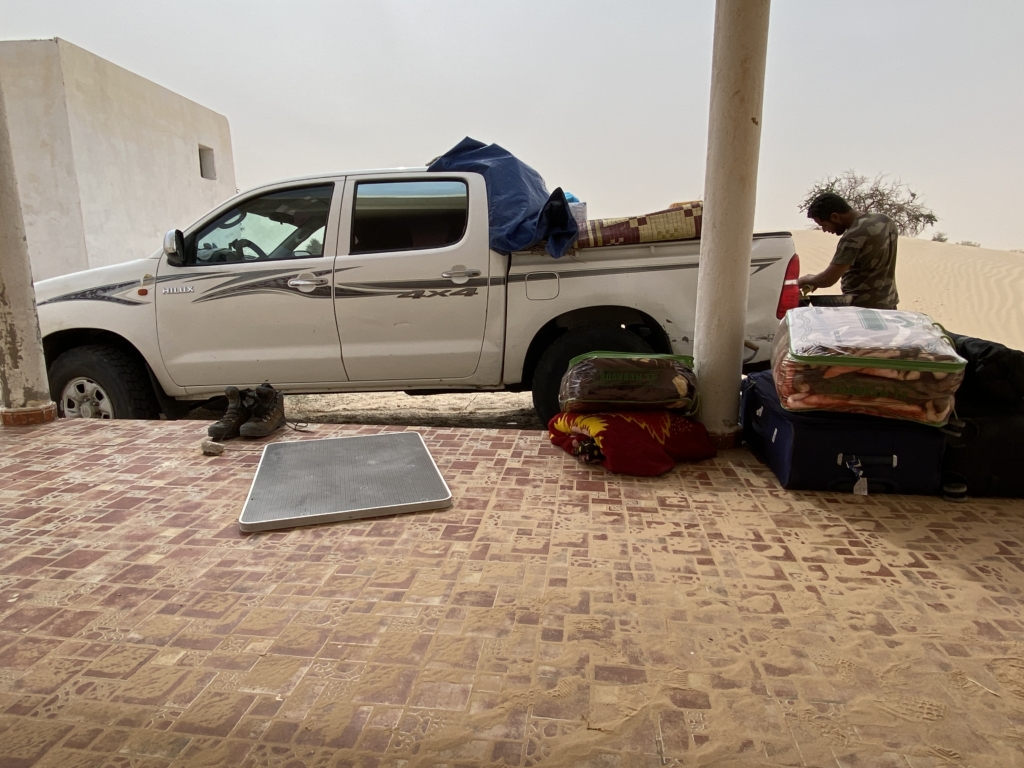
Our first stop was at the bottom of a sand dune, close to Terjit, where our tent was pitched for the night. We watched the sky turn orange during sunset and then had a wonderful desert dinner.
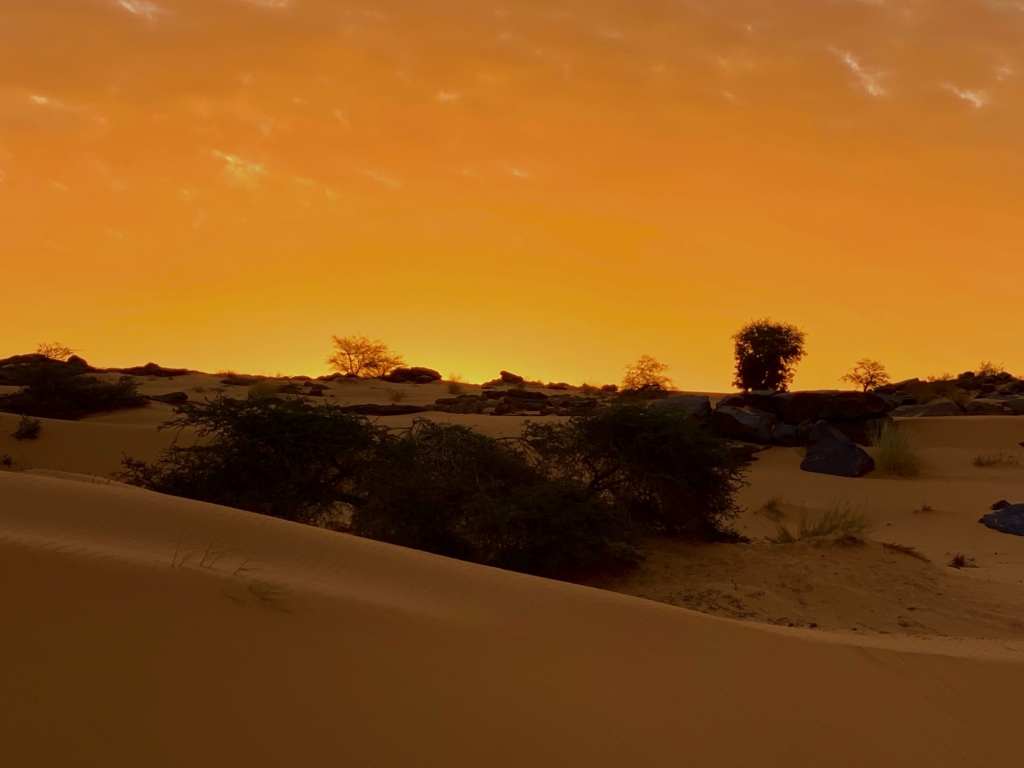
In the morning it was sunrise and breakfast. The landscape is quintessential remote-Sahara with periodic gusts of wind but not a peep or flash from civilization.
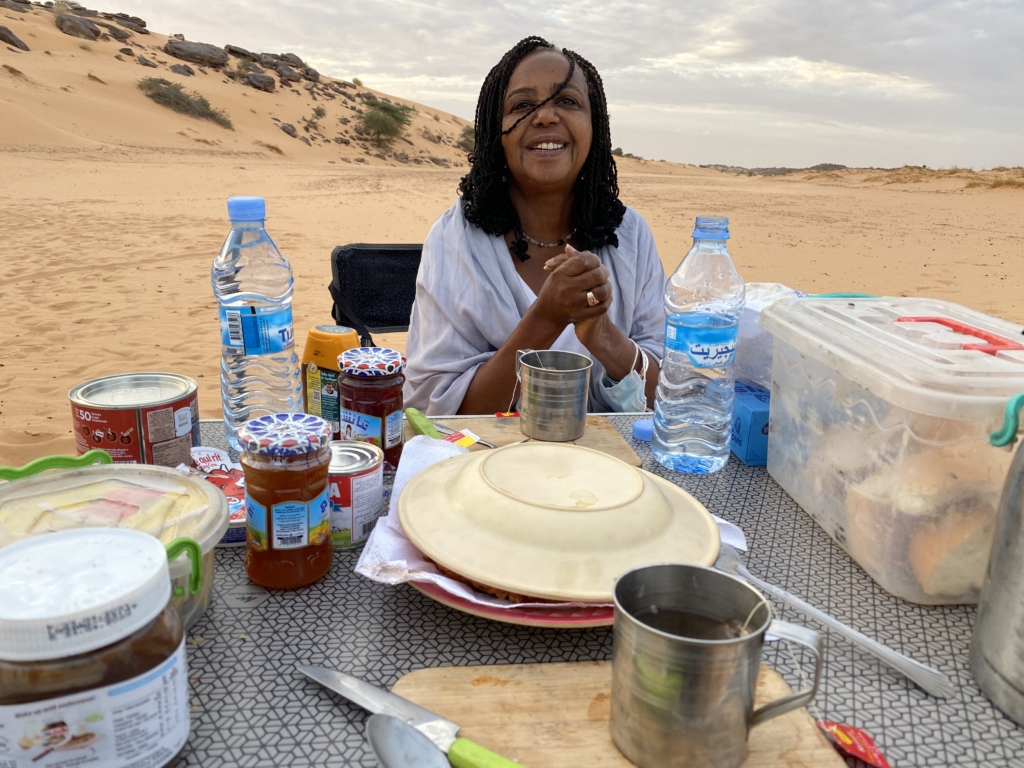
If you dreamed of what an ideal oasis would look like, it probably would describe Terjit. Guarding the entrance, there’s a small village of one-floor homes, barns and sheds, surrounded by walls, date trees and livestock. After walking over a hill and then stairs hewed into the rock, you find natural springs under picturesque palm trees.
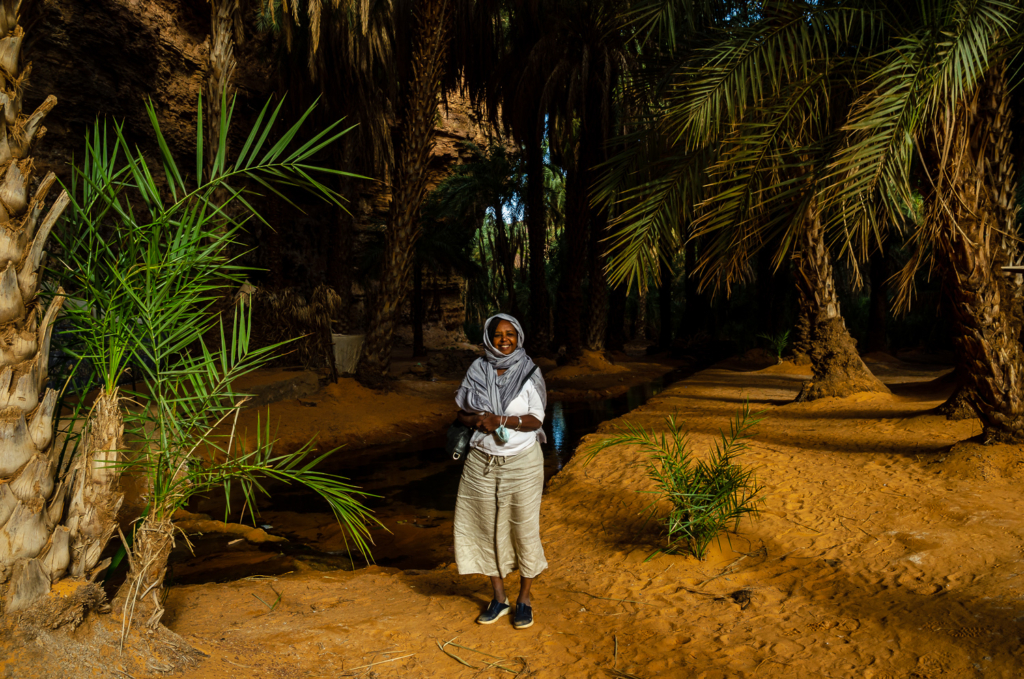
Where water was gently flowing, we noticed the temperature was appreciably lower, mostly due to the fact we were in a narrow canyon.
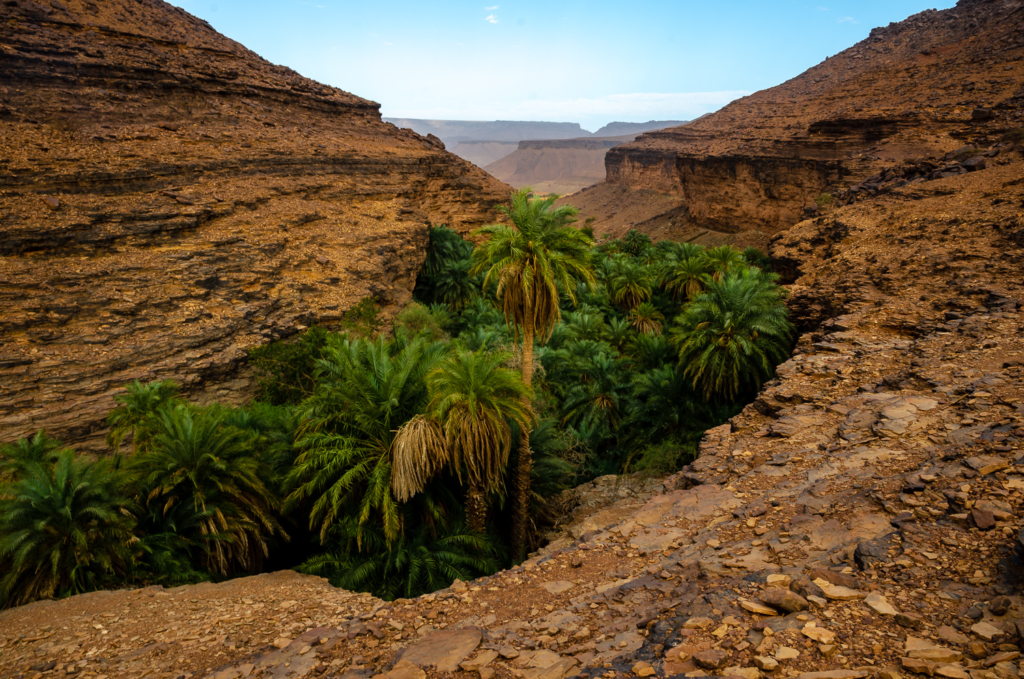
We had tea with Ali, who raises dates and sells them during the off season. He’s 51 and has (or had, not clear) five wives, but is living with only one now with two of his children, the youngest only two years old.
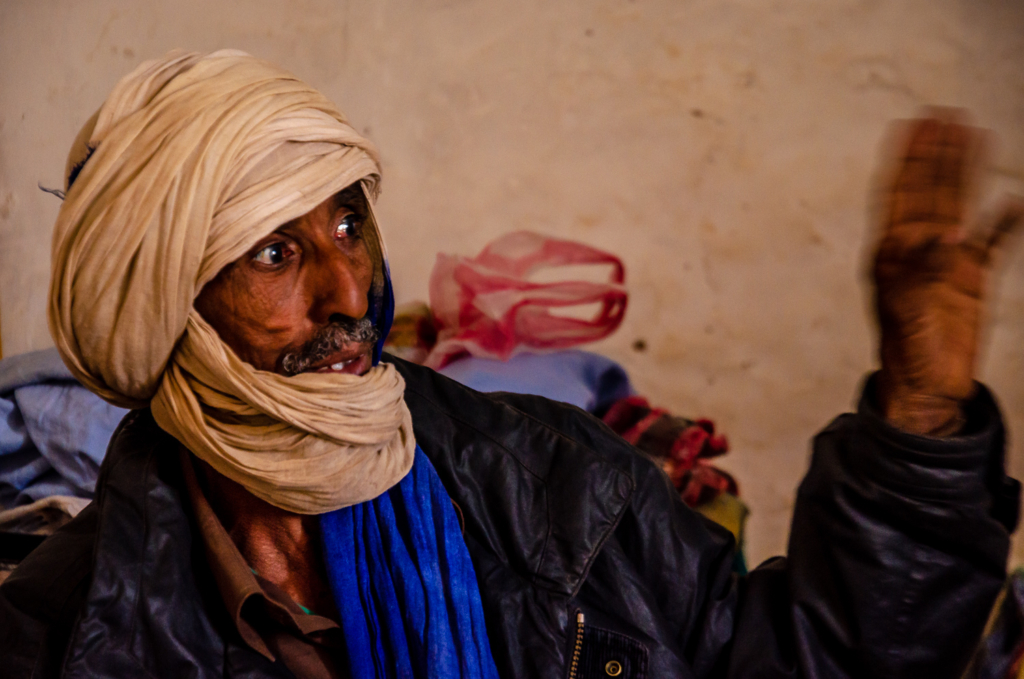
His small home was built in 1990 with horizontal stones, concrete reinforced with wire mesh and wooden doors. While the design and furnishing were exceedingly modest, he had a device helping with the internet connection.
Chinguetti
Chinguetti is one of four heritage cities; the others are Wudan (Ouadane), Oualata (Oualatais) and Tichitt, collectively a UNESCO World Heritage Site. They are all known for their fortress protections and distinctive stone designs. Over the centuries, when caravans passed through, they were centers of Islamic culture and scholarship, particularly Chinguetti.
The highlight of Chinguetti is its collection of valuable, fragile and old manuscripts of Islamic scholarship, property deeds and commercial contracts. They are kept in a “library” of dusty rooms in cardboard boxes and glass cabinets. The conservator of this treasure is Saif Islam, an unforgettable figure to all who meet him.

Saif brings the history of Chinguetti alive in his stories, told in Arabic. He even dramatically read one poem for us.
Wandering around the historic part of the ksar (fortified compound), we saw the centuries old towers, buildings and walls, some in ruins and the rest still housing residents.

Some of the doors have the characteristic historical style of bold geometric patterns.
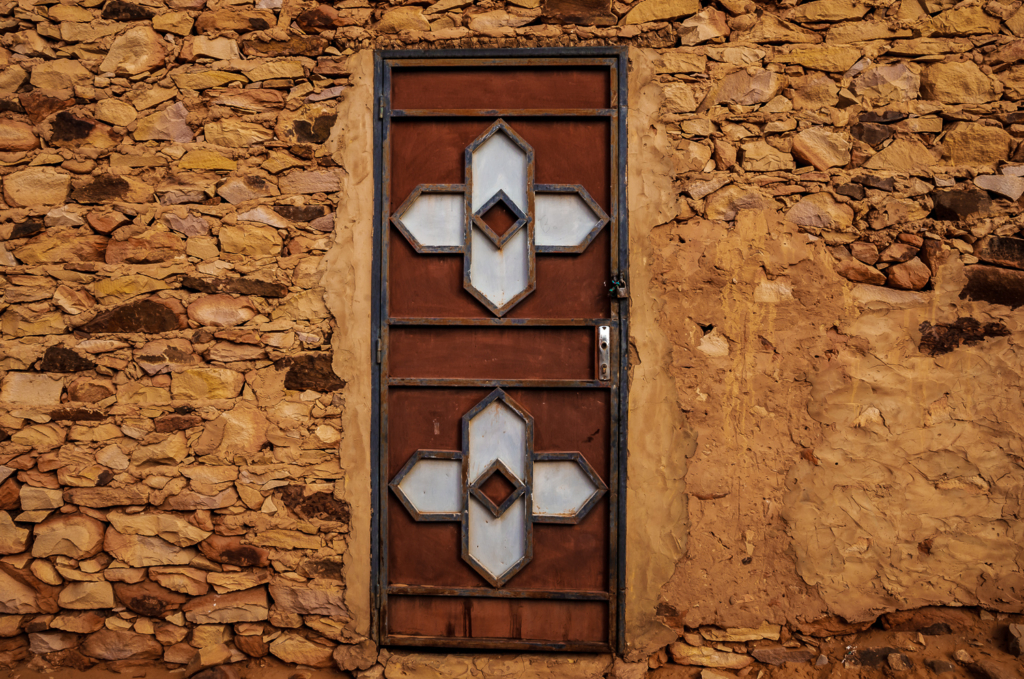
On the outskirts, there are many buildings which have been buried or in the process of. Here’s living proof that desertification is a real phenomena.
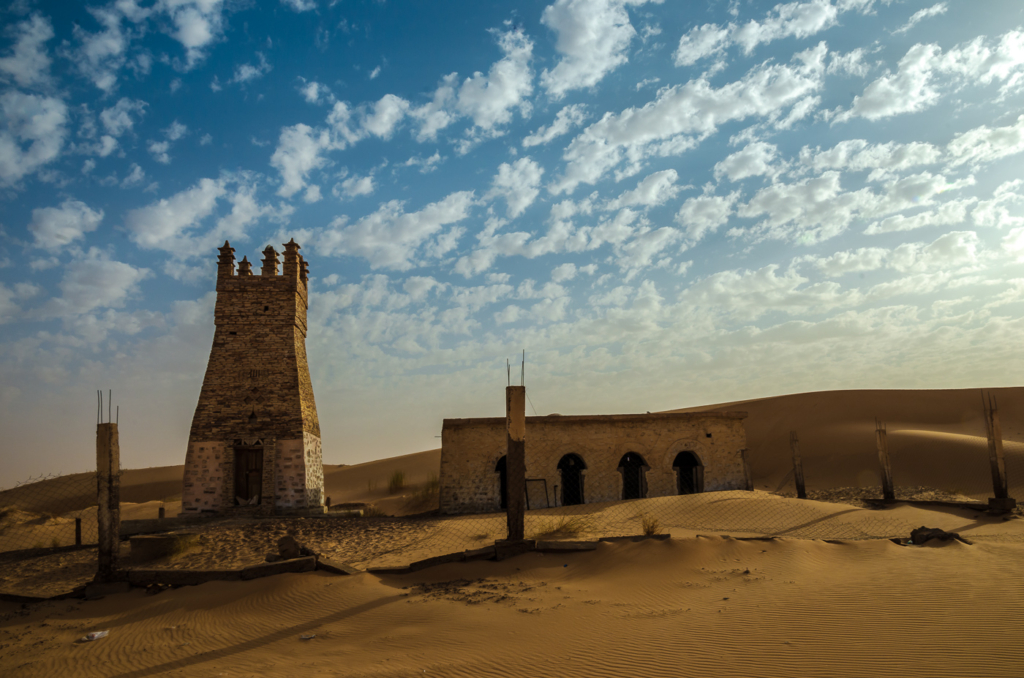
Of note, there’s a huge sand dune that Abdellahi had the skill to drive up without getting stuck, then gave us a rousing ride down the other side.
Ouadane (Wudan)
Ouadane, like its brethren historical cities, has clay, sand and stone buildings and a fortress-like design that has deterred invaders and sheltered it from the harsh environment.
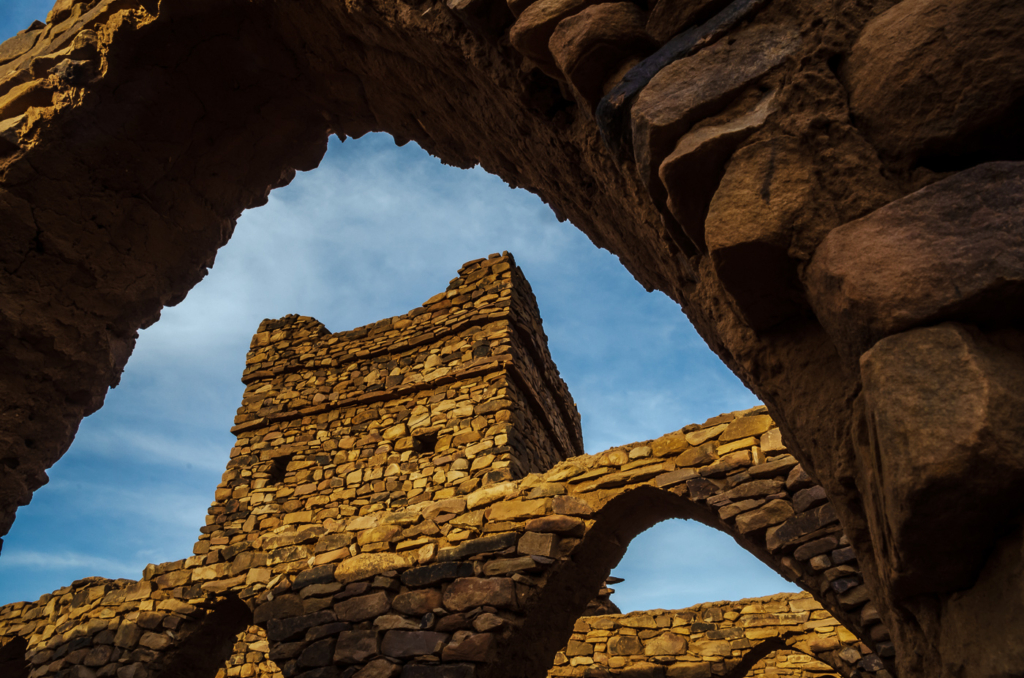
The top highlight of our trip was attending the Festival of Heritage Cities (French: Festival Des Cités Du Patrimonie). In 2021, it was in Ouadane, during the week we were there. It was not on our original itinerary, but once Imoudou knew I like music and the arts, he thought of the festival and rerouted us there. The Mauritanian President had left the day before we arrived and the performances were broadcast on national TV.
Part of the city was fenced off containing vendors from Mauritania and neighboring countries. They sold their goods in tents, on blankets and on wooden planks.

They were offering lotions and ointments, traditional masks and sculptures, Korans and manuscripts, jewelry and henna, clothing and sandals, tapestries and baskets, whole fish and sweet candies, and even souvenir T-shirts. The atmosphere was calm, as no one aggressively hawked their merchandise.
At night, we went to the stage area for the performances celebrating the culture and union of the Mauritanian people. The audience sat on thick carpets for the whole night, without jumping up and dancing. Each act would entertain the audience from ten to twenty minutes and when finished, another started performing in a few minutes. This progression went on for hours to the early morning.
There were singers, dancers, actors, musicians and poets representing the different regions and ethnic groups of the country.
Except for a handful of French tourists and foreign dignitaries, we seemed to be the only non-Mauritanians there. Seeing the audience members was fascinating including families with children, the affluent and those of moderate means, and friends of all ages.

Agrour Amogjar
The Agrour Amogjar is a 690 m / 2260 ft high peak with interesting rock formations, near the Amogjar Pass on the Adrar Plateau.
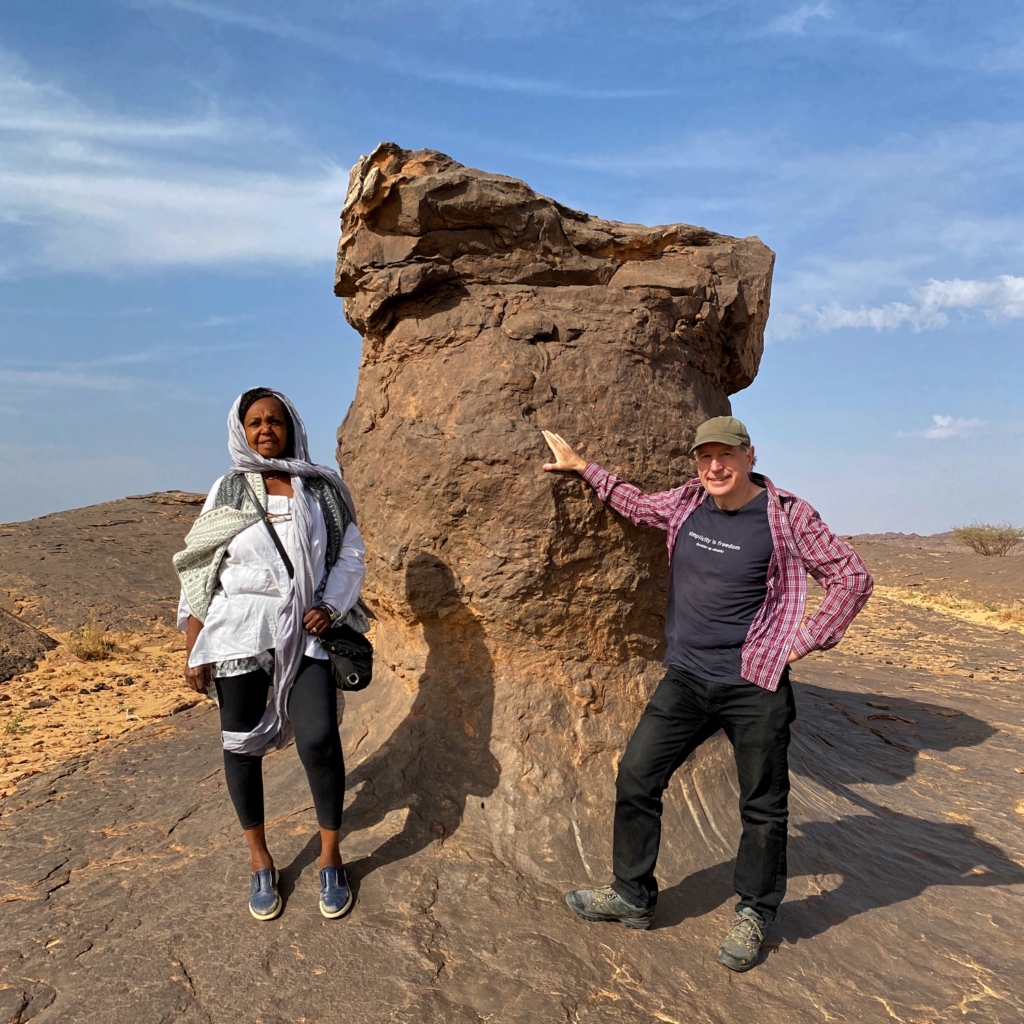
It’s known for Neolithic rock depictions of people and animals, such as this giraffe (head pointing diagonally to the upper righthand corner of the following picture).

The images have been deteriorating over the centuries. The best surviving ones usually are in a niche, protecting them from the sun, wind and rain.
It’s possible to rent camels and ride through the area.
Azougui
Driving down a steep mountain road to Azougui, we stopped for a moment to view the mountain and valley.
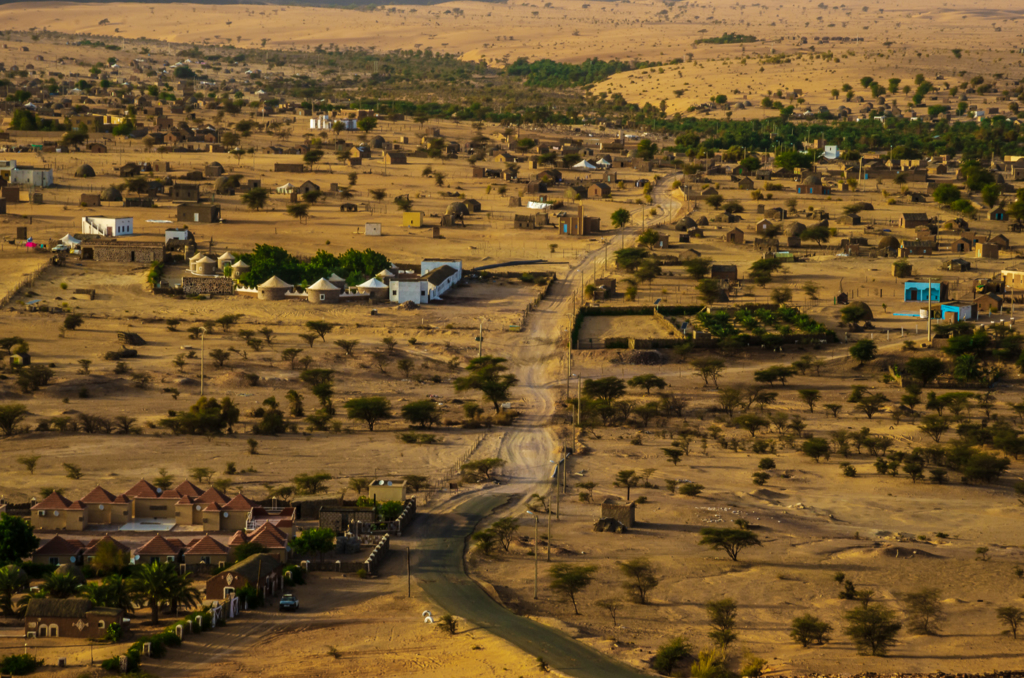
Azougui is an oasis, village and an archaeological site. Palm trees provide shade, food (dates), and materials for construction and help create a microclimate that helps retain moisture. It’s in a beautiful setting, next to mountain cliffs, pictured below with Bouha.

One thing that stood out to me was a small graveyard with irregularly shaped tombstones.
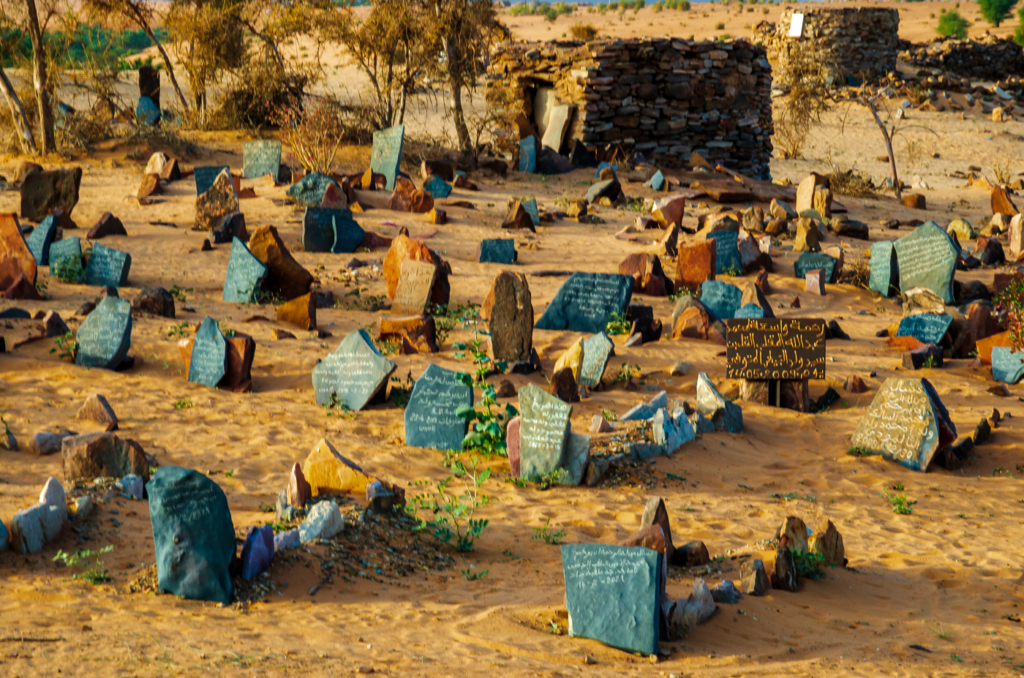
While it now has a quaint look, in the eleventh century AD, it was the first capital of the Almoravid dynasty, who in less than a century conquered a territory stretching from current day Ghana to the Iberian Peninsula.
Azougui is close to the city of Atar, which has a large market, an airport, and a 400-year old mosque.
Places We Didn’t Go To (Next Time)
There are four places I’m kicking myself because we didn’t make it there. They are relatively close in Northern Mauritania and all can be seen in a few days.
- Iron Ore Train: The 200+ car train is up to 3 km / 1.8 mi in length, travels on a single track of 700 km / 435 miles. It exports iron ore from the mines of Zouerate to the port in Nouadhibou on the Atlantic Ocean. Choum is the stop that most passengers use to board on top of the coal or in an empty container. Riding it has become a rite of passage for many extreme travelers.
- Ben Amera: Some rate it the second biggest monolith after Uluru in Australia.
- Ben Aicha: Another large monolith with adjacent rock sculptures from African and international artists.
- Graveyard of ships: Located in Nouadhibou, the second largest city in Mauritania and a major commercial center.
Other interesting places to go in Mauritania:
- Banc d’Arguin Park: A nature reserve for migratory birds and marine animals on the Atlantic coast.
- Richat Structure (Eye of the Sahara): A geological circular depression with a large hole that appears as concentric circles from the sky.
- Matmatta – A lake and river and home of the Western Sahara crocodiles, which were considered extinct just a few years ago. I learned about this from a National Geographic article.
- Tichitt: Home of a large camel market and an important place for the salt trade. In the colder months, salt caravans can be seen as they were 500 years ago. The city is partly in ruins and partly occupied and has a library of manuscripts, similar to Chinguetti. Tourism is not common despite being part of a UNESCO World Heritage Site..
- The rock formations of “The Finger” and “Elephant Rock”, near Tichitt.
- Oualata: The furthest UNESCO World Heritage city from Nouakchott. One of the most beautiful cities in Mauritania, particularly because of the richly decorated ornaments on houses and doors.
Final Thoughts
We met two caretakers of the Agrour Amogjar rock paintings area and they treated us to mint tea with a ton of sugar in their tent.
Our host boiled the tea in water for about two minutes, then let it rest until all the tea leaves settled on the bottom of the kettle. He then poured it out from high up and poured it back into the kettle. He repeated the process several times until he was satisfied it was ready.
We had tea like this a few other times, a ritual from time immemorial in Mauritania and North Africa. It provides the perfect environment to talk and share good vibes, even if you need an interpreter or use hand language. While this hospitality is common in the culture, it’s still touching, and another reason to visit Mauritania!


